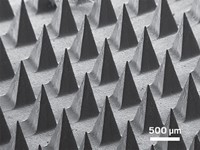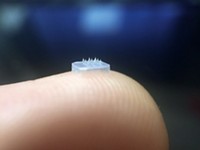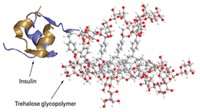Advertisement
Grab your lab coat. Let's get started
Welcome!
Welcome!
Create an account below to get 6 C&EN articles per month, receive newsletters and more - all free.
It seems this is your first time logging in online. Please enter the following information to continue.
As an ACS member you automatically get access to this site. All we need is few more details to create your reading experience.
Not you? Sign in with a different account.
Not you? Sign in with a different account.
ERROR 1
ERROR 1
ERROR 2
ERROR 2
ERROR 2
ERROR 2
ERROR 2
Password and Confirm password must match.
If you have an ACS member number, please enter it here so we can link this account to your membership. (optional)
ERROR 2
ACS values your privacy. By submitting your information, you are gaining access to C&EN and subscribing to our weekly newsletter. We use the information you provide to make your reading experience better, and we will never sell your data to third party members.
Pharmaceuticals
Patent Picks: Insulin Drug Delivery
A look at recent patenting activity in insulin drug delivery, brought to you by C&EN and CAS
by Mitch André Garcia
July 27, 2015
| A version of this story appeared in
Volume 93, Issue 30
Type 2 diabetes affects tens of millions of people around the world. Left untreated, the metabolic disorder can eventually lead to blindness, stroke, kidney and heart disease, nerve degeneration, lower limb amputation, and increased susceptibility to infection. People with the disease have high blood glucose levels because they’ve developed resistance to insulin, a peptide hormone (5,808 kilodaltons) that regulates glucose metabolism. The standard treatment for type 2 diabetes is a combination of exercise, diet changes, and medication to increase the release of insulin from the pancreas. However, as the disease progresses, many patients require insulin replacement therapy because natural production of the hormone diminishes. Traditionally, these therapies involve injecting insulin under the skin. This can be painful and inconvenient for patients, which makes them less likely to maintain proper treatment regimen. Here, we highlight three less invasive methods for insulin drug delivery from the databases of Chemical Abstracts Service (CAS).
Jump to Topics:
- Microparticles Deliver Insulin Through The Lungs
- Dentures That Deliver Drugs
- Absorbing Insulin Through A Skin Patch

Inhalers have allowed people to self-administer drugs to treat asthma, cystic fibrosis, and other lung diseases. This drug delivery route is now being used to treat systemic diseases as well. To treat type 2 diabetes, MannKind Corp. has developed inhalable microparticles comprising fumaryl diketopiperazine and insulin (US 20150031609). The diketopiperazine forms hydrogen bonds with the active monomeric form of insulin, stabilizing the peptide, so it can be delivered into the lungs. The researchers found that insulin levels in blood peaked within 12–15 minutes of patients’ inhaling the particles, which is faster than when patients inject insulin. The Food & Drug Administration approved the inhaled insulin in 2014, and MannKind currently markets the product under the trade name Afrezza. Andrea Leone-Bay, vice president of pharmaceutical development at MannKind, tells C&EN that the same technology can be used to deliver other peptides and small molecules with a mass of less than 100 kDa.

Inventors from Heraeus Kulzer GmbH have patented a design for a way to deliver drugs through dentures. By incorporating drug delivery into a product that many people use every day, the researchers believe that their method would eliminate problems with patient compliance, making it ideal for treatments of chronic diseases such as type 2 diabetes. For the new design, the researchers propose building compartments into the sides of dentures’ molars and then filling them with a drug before the denture material hardens (WO 2015071263). The compounds would slowly seep out from the compartments into the oral mucosa, where the molecules could then slip into the bloodstream, bypassing the gastrointestinal tract. Designing such compartments will be challenging because they have to be just a few cubic millimeters in size while also being chemically and mechanically stable enough to tolerate the harsh environment of the mouth. The team’s method would use polymethyl methacrylate acrylic, a shapable polymer that is already used to make dentures and is mechanically durable after hardening.

Drug companies have developed skin patches that can passively deliver small molecules such as estrogen, nicotine, nitroglycerin, and clonidine through the skin. However, these patches struggle to deliver large molecules (>1 kDa) through the thick outer layer of skin called the stratum corneum. To get the almost 6,000-kDa insulin through this barrier, Stephen Hsu and colleagues at Prometheon Pharma had to get help from laurocapram, a peptide that makes the stratum corneum more permeable. They developed a coating for transdermal patches that consists of a copolymer, poloxamer 188 and propylene glycol, and one of these peptides (WO 2014145484). The researchers tested their technology on full-thickness living human-skin tissues grown on a semipermeable membrane and found that the patches delivered insulin steadily for seven days. Devon Grimmé, director of business development at Prometheon, says they are still in the process of perfecting their formulation and are currently testing it on pigs as a first step toward a Phase I clinical trial for humans.
↑ Top
Jump to Topics:
- Microparticles Deliver Insulin Through The Lungs
- Dentures That Deliver Drugs
- Absorbing Insulin Through A Skin Patch
Mitch Garcia wrote this month’s Patent Picks in collaboration with CAS. This feature reports on trends CAS scientists observe from patents in CAS databases. Please send comments and suggestions to patentpicks@acs.org.





Join the conversation
Contact the reporter
Submit a Letter to the Editor for publication
Engage with us on Twitter